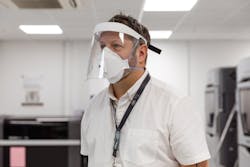An update on industrial laser responses to COVID-19 crisis issues
JLR produces protective face visors for frontline NHS staff
From the Engineering Supplier Network in the UK, the race to get essential personal protective equipment (PPE) to frontline National Health Service (NHS) staff has stepped up a gear with engineers at Jaguar Land Rover (JLR) designing and manufacturing a reusable protective visor.
Collaborating with other companies, JLR is targeting production of 5000 visors a week for NHS trusts across the UK. They intend to make open-source computer-aided design (CAD) files available to additive manufacturers and suppliers in order to produce many more protective visors over the coming weeks.
The NHS-approved visor design was developed in consultation with healthcare professionals for rapid prototype printing at JLR’s Advanced Product Creation Centre (Gaydon, England). Rapid prototyping enables engineers to work through several iterations of the design in under a week, allowing medical staff to provide feedback and improve the design.
JLR trialed different materials and improved the design over several iterations in consultation, with frontline doctors and nurses, to create something unique and truly fit-for-purpose. Collaborative teams working at JLR, along with the wider CAD and 3D printing community, will continue to do what they can to help healthcare workers.According to JLR, the clear shield is manufactured using chemically resistant polycarbonate, trimmed down by RGH Rubber Limited (Great Dunmow, England) using a multi-cutter machine. Created using laser sintering, jet fusion, and fused deposition modeling (FDM) processes, the team made sure the cap top can be worn comfortably and safely for many hours. A secure elastic strap, provided by Beacon Trimmings (Coventry, England), holds the visor in place and can be quickly and easily replaced to avoid contamination. Final assembly has been undertaken by a skeleton team of four Jaguar Land Rover employees in a specially designed clean area.
3D printing face mask headbands, test swabs
And in the U.S. to assist medical workers fighting COVID-19 in its local communities, Nexteer Automotive (Auburn Hills, MI) is using its 3D printers in Saginaw, MI and Tychy, Poland to make plastic masks and face shield headbands. Nexteer is working with local government and medical organizations to donate the supplies to nearby medical facilities.
Nexteer is currently producing approximately 50 face masks and 100 face shields each day. Regarding face mask production in Saginaw, the company is exploring additional manufacturing processes expected to increase capacity to more than 1000 masks per day. Regarding face shield production in Tychy, the company is providing complete face shields to the medical community by 3D printing the headbands and procuring the plastic face shields from a third party.
Also in the U.S., 3D printing is being used to make Coronavirus test swabs. Northwell Health, New York’s largest healthcare provider, took matters into its own hands and started 3D printing nasal swabs used for COVID-19 testing. Northwell said its focus on swabs was part of an effort to avoid supply shortages related to the components for kits used in testing for COVID-19, the highly contagious, sometimes deadly respiratory disease caused by the Coronavirus. Health experts have said widespread testing is the best way to track and trace the spread of the virus.
Researchers at Northwell and three other institutions—the University of South Florida, Tampa General Hospital (both in Tampa, FL), and 3D printing company Formlabs (Somerville, MA)—devised a way to print the swabs needed to collect mucous and cell samples, according to lead researcher Todd Goldstein, Northwell's director of 3D design and innovation.
Pilot study results showed the devices are safe and effective, and it has begun printing them as needed, Northwell spokesman Matthew Libassi said. It can print up to 3000 a day.
The four participants plan to share the prototype with other institutions. Any hospital with a 3D printer and the materials could make their own swabs, Northwell said.

